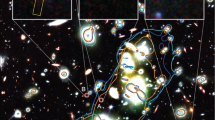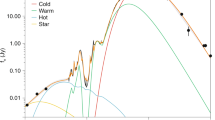Abstract
THE question of when galaxies and stars started to form in the early Universe is one of the most fundamental in cosmology. Faint radio sources (with fluxes of a few microjanskys or less) may be these early galaxies; radio surveys have shown them to be increasingly common as fainter levels are reached1-7, suggesting that they are an important constituent of the early Universe. Many of these sources were identified with faint blue galaxies—some of which have peculiar morphology (perhaps arising from inter actions) 1,8-10 or with galaxies hosting enhanced star formation activity10-12, but lack of optical resolution has made the nature of these identifications rather uncertain. Here we present the results of a very deep radio survey, obtained with the Very Large Array, of a field imaged with the Wide Field Camera on the Hubble Space Telescope. We find that most of the microjansky sources are indeed faint blue galaxies, with light profiles resembling disk galaxies. More than half of these galaxies occur in pairs or small groups, compared to fewer than ten per cent of nearby galaxies. We conclude that the microjansky sources are luminous disk galaxies, in a starburst (or post-starburst) phase that was triggered by interactions or mergers. Only a few show evidence for an active nucleus2,13,14, which is the other possible power source for the emission.
This is a preview of subscription content, access via your institution
Access options
Subscribe to this journal
Receive 51 print issues and online access
$199.00 per year
only $3.90 per issue
Buy this article
- Purchase on Springer Link
- Instant access to full article PDF
Prices may be subject to local taxes which are calculated during checkout
Similar content being viewed by others
References
Windhorst, R. A., Miley, G. K., Owen, F. N., Kron, R. G. & Koo, D. C. Astrophys. J. 289, 494–513 (1985).
Windhorst, R. A., Fomalont, E. B., Partridge, R. B. & Lowenthal, J. D. Astrophys. J. 405, 489–517 (1993).
Condon, J. J. Astrophys. J. 338, 13–23 (1989).
Kellermann, K. I. & Wall, J. V. in Observational Cosmology (eds Hewitt, A., Burbidge, G. & Fang, L. Z.) 545–564 (IAU Symp. 124, Reidel, Dordrecht, 1987).
Fomalont, E. B., Windhorst, R. A., Kristian, J. A. & Kellermann, K. I. Astr. J. 102, 1258–1277 (1991).
Fomalont, E. B., Partridge, R. B., Lowenthal, J. D. & Windhorst, R. A. Astrophys. J. 404, 8–20 (1993).
Condon, J. J. Astrophys. J. 287, 461–174 (1984).
Kron, R. G., Koo, D. C. & Windhorst, R. A. Astr. Astrophys. 146, 38–58 (1985).
Weistrop, D., Wall, J. V., Fomalont, E. B. & Kellermann, K. I. Astr. J. 93, 805–810 (1987).
Windhorst, R. A., Dressier, A. & Koo, D. C. in Observational Cosmology (eds Hewitt, A., Burbidge, G. & Fang, L. Z.) 573–576 (IAU Symp. 124, Reidel, Dordrecht, 1987).
Benn, C. R., Rowan-Robinson, M., McMahon, R. G., Broadhurst, T. J. & Lawrence, A. Mon. Not. R. astr. Soc. 263, 98–122 (1993).
Thuan, T. X. & Condon, J. J. Astrophys. J. 322, L9–L14 (1987).
Oort, M. J. A. & Windhorst, R. A. Astr. Astrophys. 145, 405–424 (1985).
Donnelly, R. H., Partridge, R. B. & Windhorst, R. A. Astrophys. J. 321, 94–112 (1987).
Windhorst, R. A. et al. Astr. J. 107, 930–945 (1994).
Griffiths, R. E. et al. Astrophys. J. 437, 67–82 (1994).
Windhorst, R. A., Mathis, D. F. & Keel, W. C. Astrophys. J. 400, L1–L4 (1992).
Windhorst, R. A. et al. Astrophys. J. 435, 577–598 (1994).
Keel, W. C. & Windhorst, R. A. Astr. J. 106, 455–465 (1993).
Casertano, S. et al. Astrophys. J. (submitted).
Ratnatunga, K. U., Griffiths, R. E., Casertano, S., Neuschaefer, L. W. & Wyckoff, E. W. Astr. J. 108, 2362–2372 (1994).
Condon, J. J. A. Rev. Astr. Astrophys. 30, 575–612 (1992).
Windhorst, R. A., Kron, R. G. & Koo, D. C. Astr. Astrophys. Suppl. Ser. 58, 39–87 (1984).
Mitchell, K. et al. Publ. astr. Soc. Pacif. 93, 647–654 (1981).
Ostriker, J. P. & Heisler, J. Astrophys. J. 278, 1–10 (1984).
Burkey, J. M., Keel, W. C., Windhorst, R. A. & Franklin, B. E. Astrophys. J. 429, L013–L017 (1994).
Griffiths, R. E. et al. Astrophys. J. 435, L019–L022 (1994).
Windhorst, R. A., Mathis, D. F. & Neuschaefer, L. W. in Evolution of the Universe of Galaxies (ed. Kron, R. G.) 389–403 (ASP Conf. Ser. Vol. 10, Bookcrafters, Provo, UT, 1990).
Dressler, A. & Gunn, J. E. Astrophys. J. 270, 7–19 (1983).
Patnaik, A. R., Browne, I. W. A., Wilkinson, P. N. & Wrobel, J. M. Mon. Not. R. astr. Soc. 254, 655–676 (1992).
Author information
Authors and Affiliations
Rights and permissions
About this article
Cite this article
Windhorst, R., Fomalont, E., Kellermann, K. et al. Identification of faint radio sources with optically luminous interacting disk galaxies. Nature 375, 471–474 (1995). https://doi.org/10.1038/375471a0
Received:
Accepted:
Issue Date:
DOI: https://doi.org/10.1038/375471a0
This article is cited by
-
Anisotropies of the cosmic microwave background
La Rivista del Nuovo Cimento (2002)
-
Resolving the extragalactic hard X-ray background
Nature (2000)
Comments
By submitting a comment you agree to abide by our Terms and Community Guidelines. If you find something abusive or that does not comply with our terms or guidelines please flag it as inappropriate.



